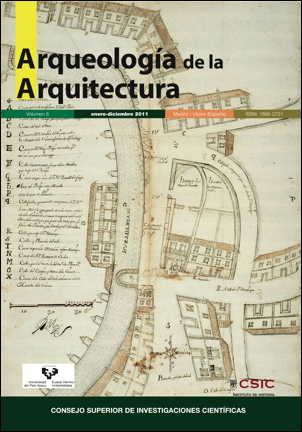The evolution of the colour in the eaves of the façade of the palace of the king Pedro I, Royal Palace of Seville. Contribution of the study of materials to the identification of the conservation works undertaken throughout its history
DOI:
https://doi.org/10.3989/arqarqt.2011.10016Keywords:
Mudejar art, polychromy, pigments, binding media, coloured varnish, gold, preparatory layer, wood support, eaveAbstract
Results from the research carried out on the polychrome decoration of the façade of the King Pedro I Palace, which was built as part of the Alcázar of Seville between 1356 and 1366, are here explained. This building is regarded as one of the most important examples of architecture from al-Andalus in the Iberian Peninsula. The polychromy of its façade has been subject to numerous interventions throughout its history, but its general appearance remains largely unchanged, variations can be observed in details though. The predominant finishing has always been golden, on a background of reds, blues and greens. After an accuracy painstaking and sampling fieldwork, various laboratory techniques were brought together to identify and study the inorganic and organic phases that comprise the pictorial layers. Such techniques include optical microscopy with reflected and transmitted light, X-rays powder diffraction, scanning electron microscopy with EDX microanalysis, gas chromatography and high pressure liquid chromatography. At least eight polychrome decorations have been identified, corresponding to different levels carried out in different epochs. Each decoration has usually several layers: preparatory, base, and pictorial or golden foil layer, being the latter the most commonly used as finishing layer. The decorations use a wide variety of pigments: red lead, cinnabar/vermilion, lead white, natural and synthetic azurite, synthetic ultramarine, malachite, emerald green, As-Cu green, lead-tin yellow, chrome yellow, yellow litharge, and organic black. Detailed study of the textures and the precise characterization of the pigments used on the façade have enabled the successive interventions to be dated and their spatial correlation to be identified. Regarding the original pigments, remains of lead red and cinnabar were found, followed by layers of cinnabar/vermilion, azurite and malachite, these of natural origin. It was identified that in those decorations dated between the 16th and 18th century cinnabar is replaced by vermilion, and natural azurite is replaced by its synthetic equivalent. More recent interventions reveal that the most widely-used pigment is emerald green (synthesised from 1814 onwards), this constituting a reference level. From the late 19th century onwards, some emerald greens and synthetic azurite blues are replaced by synthetic ultramarine.
Downloads
References
Almagro Gorbea, A. (2007). El Alcázar de Sevilla. Un palacio musulmán para un rey cristiano. XI Congreso de Estudios Medievales «Cristianos y musulmanes en la península Ibérica: la guerra, la frontera y la convivencia. 333-365
Almagro Gorbea, A. (Coord.) (2009). La Portada del Palacio de Pedro I. Investigación y restauración. Apuntes del Alcázar de Sevilla 6, 44-67.
Almagro, A., García Bueno, A., López Cruz, O., Medina Flórez, V. (2010). Restauración de la fachada del Palacio de Pedro I. 2ª fase lateral derecho. Apuntes del Alcázar de Sevilla 11, 8-37.
Almagro, A., García Bueno, A., López Cruz, O., Medina Flórez, V. (2011). Restauración de la fachada del Palacio de Pedro I. 3ª fase lateral izquierdo. Apuntes del Alcázar de Sevilla 12. (En prensa).
Brogiolo, G.P. (1995). Arqueología estratigráfica y restauración, Informes de la Construcción, 46, nº 435, 31-35.
Bruquetas, R. (2002). Técnicas y materiales de la pintura española en los siglos de oro. Ed. Fundación de Apoyo a la Historia del Arte Hispánico.
Calvo, A. (2003). Conservación y Restauración. Materiales, técnicas y procedimientos. Ed. del Serbal, Barcelona.
Chávez González, M.R. (2004). El Alcázar de Sevilla en el siglo XIX. Patronato del Real Alcazar de Sevilla, Sevilla.
Cómez Ramos, R. (2006). El Alcázar del Rey Don Pedro. Diputación de Sevilla. Eastaugh, N., Walsh, V., Chaplin, T., Siddall, R. (2004). The pigment compendium. Optical microscopy of historical pigments. Elsevier, Amsterdan.
Gestoso Pérez, J. (1899). Guía histórico descriptiva del Alcázar de Sevilla. Escuela Tipográfica Sevillana. Sevilla.
Harley, R.D. (2001). Artists’ Pigments c. 1600-1835. A study in English documentary sources. (2ª ed). Archetype London.
Lleó Cañal, V., García, M. (2002). El Real Alcázar de Sevilla. Patronato del Real Alcázar. Sevilla.
López Pertíñez, M.C., 2006, La Carpintería en la arquitectura Nazarí. García Bueno, A. «La Policromía en la carpintería Nazarí», pp. 68-87, Ed. Junta de Andalucía.
Manzano Martos, R. (1983). Poetas y Vida Literaria en los Reales Alcázares de la Ciudad de Sevilla. Real Academia de Buenas Letras de Sevilla.
Marín Fidalgo, A. (1990). El Alcázar de Sevilla bajo los Austrias. Guadalquivir. Sevilla.
Matteini, M., Moles, A. (2008). La química en la restauración. Los materiales del arte pictórico. (2ª ed). Nerea. San Sebastián.
Downloads
Published
How to Cite
Issue
Section
License
Copyright (c) 2011 Consejo Superior de Investigaciones Científicas (CSIC) - Universidad del País Vasco/Euskal Herriko Unibertsitatea (UPV/EHU)

This work is licensed under a Creative Commons Attribution 4.0 International License.
© CSIC. © UPV/EHU. Manuscripts published in both the print and online versions of this journal are the property of Consejo Superior de Investigaciones Científicas and Universidad del País Vasco/Euskal Herriko Unibertsitatea, and quoting this source is a requirement for any partial or full reproduction.
All contents of this electronic edition, except where otherwise noted, are distributed under a Creative Commons Attribution 4.0 International (CC BY 4.0) licence. You may read the basic information and the legal text of the licence. The indication of the CC BY 4.0 licence must be expressly stated in this way when necessary.
Self-archiving in repositories, personal webpages or similar, of any version other than the final version of the work produced by the publisher, is not allowed.















